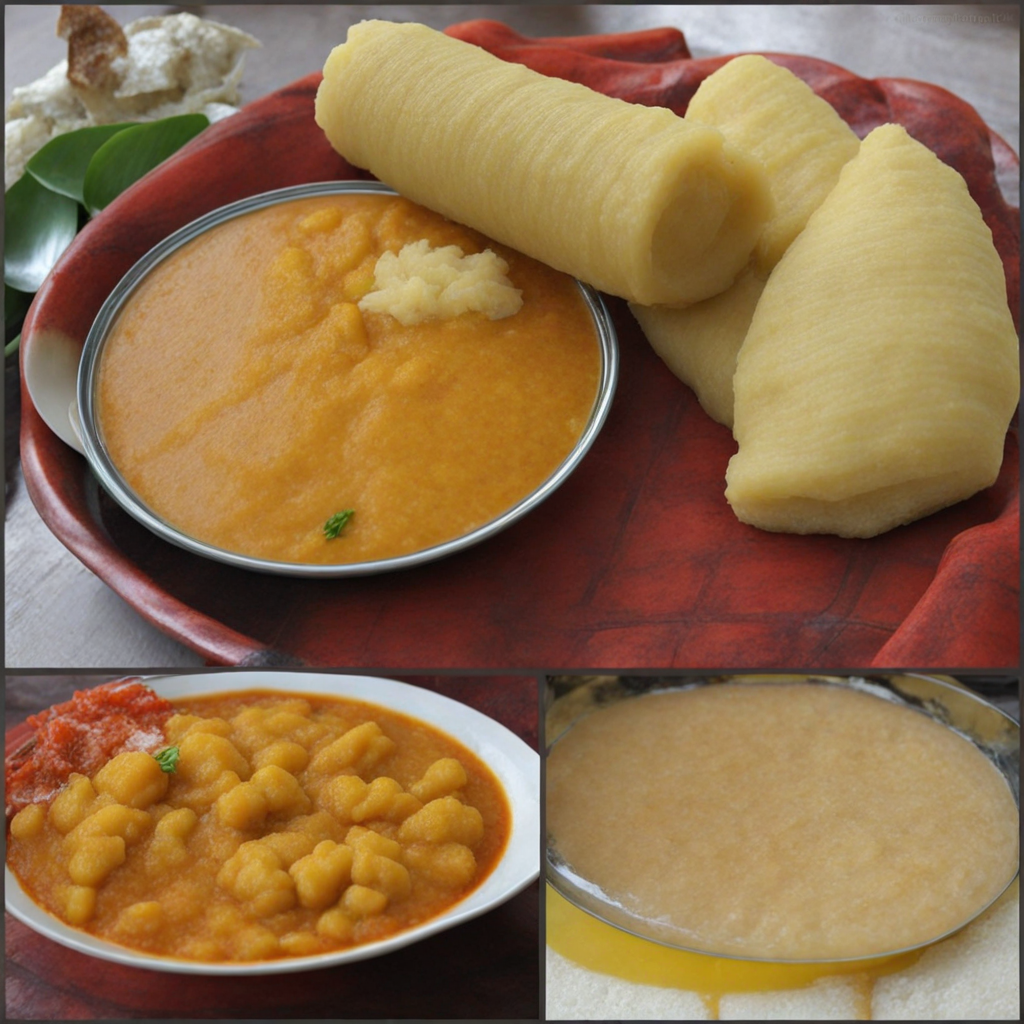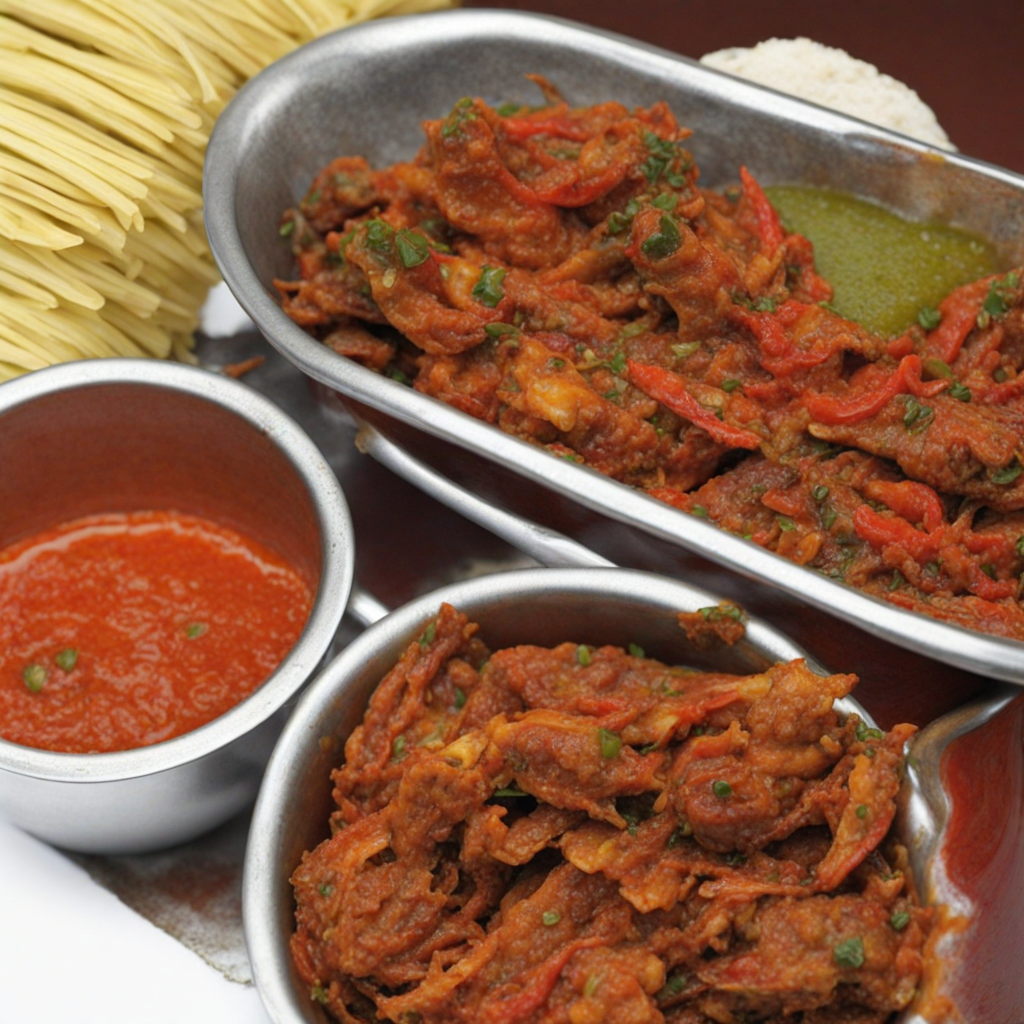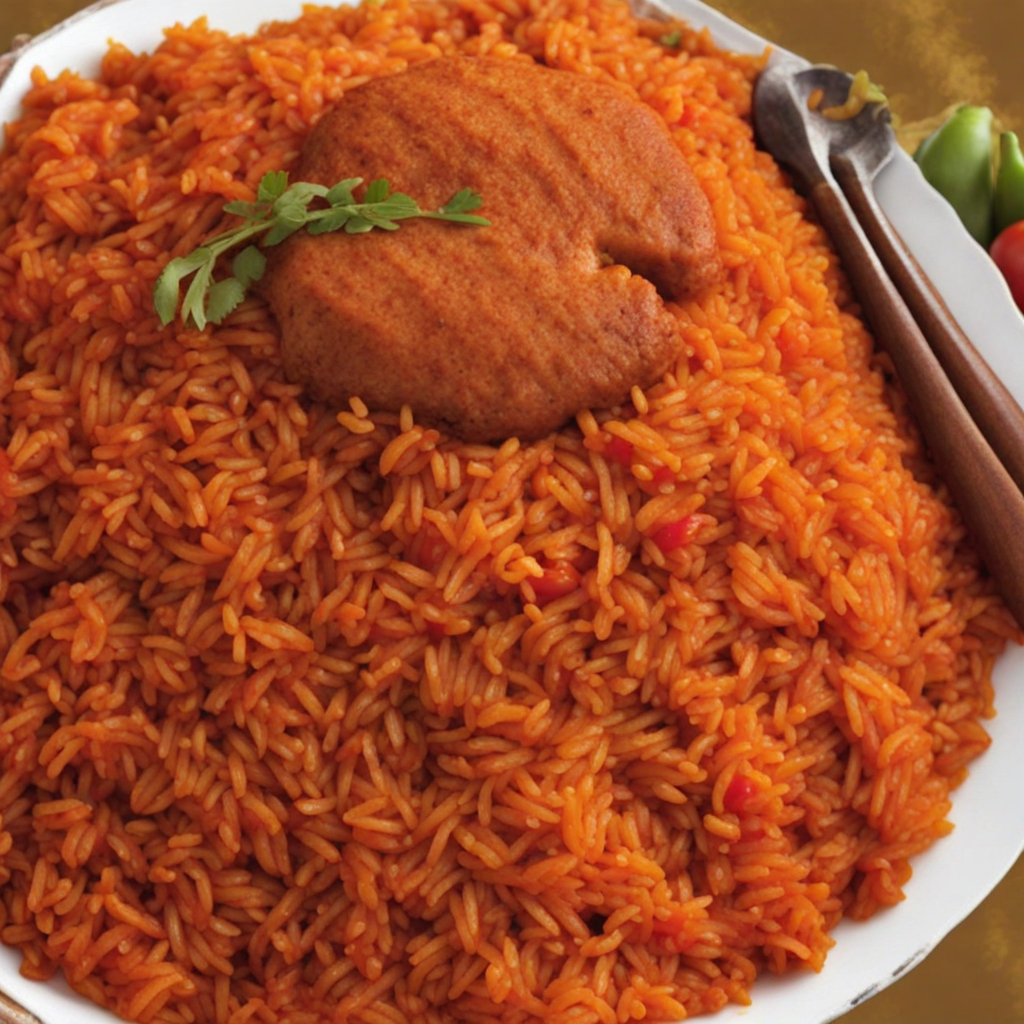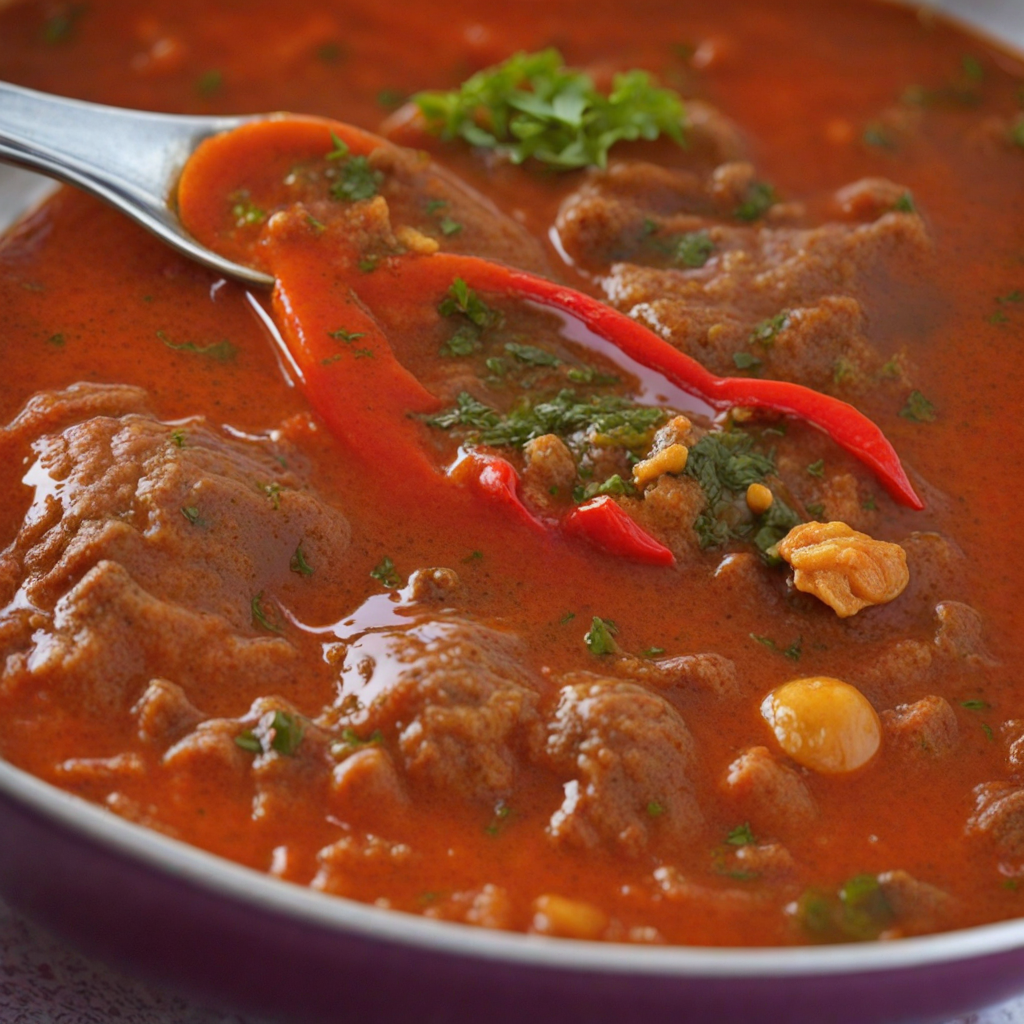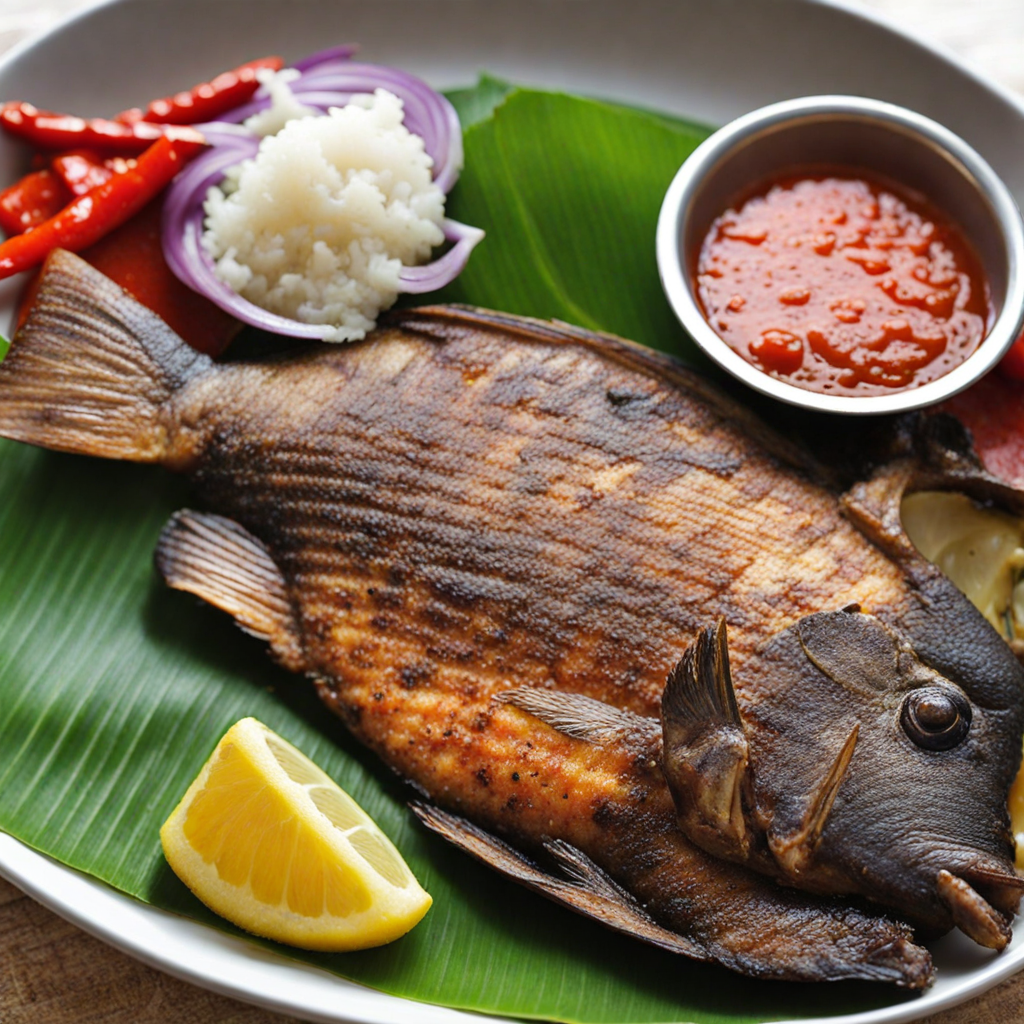Banku
Banku is a traditional Ghanaian dish made from fermented corn and cassava dough, which is cooked to create a smooth, slightly sour dough-like consistency. The preparation begins with the fermentation process, where the corn and cassava are soaked and ground, then mixed with water and cooked over heat while being stirred continuously. This results in a thick, elastic texture that is both comforting and satisfying. The unique fermentation gives Banku its characteristic tangy flavor, which pairs beautifully with a variety of sauces and stews. Served as a staple food in many Ghanaian households, Banku is often enjoyed with rich soups and stews, such as groundnut (peanut) soup or fish stew. The texture of Banku is soft and pliable, allowing it to be easily molded into balls or scooped up with fingers, making it an interactive dining experience. The dish is not only filling but also serves as a perfect accompaniment to proteins, enhancing their flavors with its mild sourness. In addition to its delicious taste, Banku is a versatile dish that can be adapted to suit various palates. It can be paired with grilled fish, spicy pepper sauces, or vegetable stews, catering to both meat lovers and vegetarians alike. Whether you are savoring it at a local eatery or trying your hand at making it at home, Banku offers a delightful glimpse into Ghanaian culinary culture, inviting food enthusiasts to explore its rich flavors and textures.
How It Became This Dish
The History of Banku: A Cultural Staple of Ghana Origin and Ingredients Banku, a beloved dish in Ghana, particularly among the Ewe and Fante people, is a fermented corn and cassava dough that is cooked to create a smooth, elastic, and slightly sour staple food. The origins of Banku can be traced back to the coastal regions of Ghana, where the availability of cassava and maize made them the primary ingredients. While maize is native to the Americas, it arrived in West Africa through trade in the 16th century, and its integration into local diets was transformative. Cassava, on the other hand, was introduced from South America by Portuguese traders in the 16th century and quickly became a staple throughout the region. The preparation of Banku is a time-honored process that involves soaking corn and cassava in water for several days to ferment. This fermentation process not only enhances the flavor but also increases the nutritional value of the dish. The combination of corn and cassava creates a unique texture and taste that sets Banku apart from other staple foods in Ghana. The dough is then cooked in boiling water while being stirred until it reaches a smooth, stretchy consistency. Traditionally, Banku is served with a variety of soups, stews, or sauces, making it a versatile accompaniment to many Ghanaian dishes. Cultural Significance Banku is more than just a meal; it is a significant cultural symbol in Ghana. It reflects the agricultural practices, communal spirit, and culinary traditions of the people. The dish is often associated with communal eating, where families and friends gather to enjoy meals together. This practice reinforces social bonds and strengthens community ties, highlighting the importance of shared experiences in Ghanaian culture. In the coastal regions, particularly among the Ewe people, Banku is often paired with grilled fish and spicy pepper sauce, creating a delightful combination that showcases the region's rich fishing heritage. The choice of accompaniments varies by region; in other areas, it might be served with groundnut soup, okra stew, or a variety of meat-based dishes. Each pairing not only enhances the flavor profile of Banku but also represents local culinary traditions and available resources. Banku is also significant in various cultural ceremonies and celebrations. It is often served during festive occasions, weddings, and communal gatherings, symbolizing hospitality and the importance of family and community. The preparation and sharing of Banku during these events highlight the values of generosity and togetherness that are central to Ghanaian culture. Development Over Time The evolution of Banku reflects broader changes in Ghanaian society, including shifts in agricultural practices, urbanization, and globalization. Historically, Banku was primarily prepared in rural communities, where the fermentation process was a communal activity. Women would gather to soak the corn and cassava, sharing stories and traditions while they worked. This practice not only preserved the cultural heritage of the dish but also fostered a sense of community among participants. As urbanization began to reshape Ghanaian society in the late 20th century, the way Banku was prepared and consumed started to change. Many people moved to urban areas in search of better opportunities, leading to a decline in traditional agricultural practices. Consequently, the preparation of Banku began to shift from a communal to a more individual endeavor. Modern conveniences, such as pre-packaged Banku flour and ready-to-cook mixes, emerged, making it easier for urban dwellers to enjoy this traditional dish without the time-consuming fermentation process. However, this shift has not diminished the cultural significance of Banku. Rather, it has adapted to the changing lifestyles of Ghanaians while remaining a staple food. The rise of street food culture in Ghana has also played a role in the development of Banku. Street vendors now offer Banku alongside a variety of accompaniments, making it accessible to a broader audience. This modernization has allowed Banku to maintain its relevance in contemporary Ghanaian cuisine, appealing to both traditionalists and younger generations. In recent years, there has been a renewed interest in traditional foods and culinary heritage, driven by a growing awareness of the importance of food security and sustainability. As Ghanaians increasingly seek to reconnect with their roots, Banku has enjoyed a renaissance. Chefs and home cooks alike are rediscovering traditional recipes, experimenting with new flavors, and promoting the dish as a symbol of national identity. Global Recognition The globalization of food culture has also contributed to the rising popularity of Banku beyond Ghana's borders. As the Ghanaian diaspora grows, so too does the demand for authentic Ghanaian cuisine. Restaurants serving traditional Ghanaian dishes, including Banku, have opened in various countries, allowing people from different backgrounds to experience the rich flavors of Ghanaian culinary traditions. Cookbooks and food blogs highlighting Ghanaian recipes have further popularized Banku, introducing it to a wider audience eager to explore diverse global cuisines. This recognition has also sparked interest in the nutritional benefits of Banku. As health consciousness rises globally, many are turning to traditional foods that are naturally fermented and made from whole ingredients. Banku, with its combination of corn and cassava, offers a good source of carbohydrates and dietary fiber, making it an appealing choice for health-conscious consumers. Conclusion In summary, Banku is a dish steeped in history and cultural significance, embodying the agricultural practices and communal values of the Ghanaian people. From its origins in the coastal regions to its contemporary adaptations in urban settings, Banku reflects the resilience and adaptability of Ghanaian cuisine. The dish serves as a culinary bridge connecting generations, communities, and even cultures. As it continues to evolve, Banku remains a proud symbol of Ghana's rich culinary heritage, reminding us of the importance of food in fostering connection and tradition. Whether enjoyed in a bustling city or a rural village, Banku is a testament to the enduring legacy of Ghanaian culture and its celebration of community through food.
You may like
Discover local flavors from Ghana



